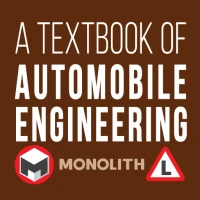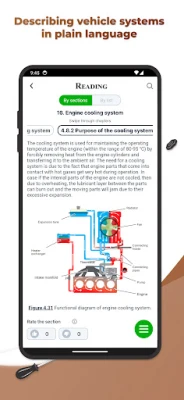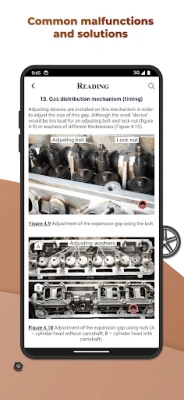
Latest Version
2.0.6
April 17, 2025
Monolith publisher
Education
Android
0
Free
com.monolit.carstructure
Report a Problem
More About Automobile Engineering Book
The Ultimate Guide to Understanding Modern Cars: A Comprehensive Resource for Drivers
Learning about cars can be an exciting journey, especially when the information is presented in an engaging and accessible manner. This guide is designed to provide a wealth of knowledge about modern automobiles, making it an invaluable resource for driving school students, novice drivers, and anyone interested in gaining a foundational understanding of vehicles.
What You Will Discover in This Guide
- Essential insights into the mechanisms of contemporary cars
- A detailed list of common car malfunctions and their solutions
- Guidelines for proper operation and maintenance of vehicles
- Clear explanations of car systems in layman's terms
- Practical information to boost your confidence on the road
This Guide is Perfect For:
- Students enrolled in driving schools and new drivers
- Parents eager to ensure their children are well-prepared
- All drivers seeking to deepen their understanding of their vehicles
- Service managers aiming for better communication with customers
Table of Contents
- Introduction
- History of Automobiles
- Types of Passenger Car Bodies
- Wheel Configurations
- Car Classifications
- Key Components of Passenger Cars
- Layouts of Major Vehicle Components
- Fundamental Technical Specifications of Cars
- Understanding Engines
- Single-Cylinder Internal Combustion Engines
- Engine Classifications
- Technical Specifications of Engines
- Gas Distribution Mechanism (GDM)
- Cylinder Head
- Engine Block and Crankshaft
- Engine Cooling Systems
- Engine Lubrication Systems
- Air Intake and Exhaust Systems
- Fuel Systems: Gasoline vs. Diesel
- Modern Engine Fuel Systems
- Transmission Functions
- Manual vs. Automatic Transmissions
- Drive Gears and Differentials
- Drive Shafts and Joints
- All-Wheel Drive Vehicles
- Car Suspension Systems
- Wheels and Tires: Functions and Markings
- Wheel Alignment Angles
- Brake Systems: Purpose and Components
- Anti-Lock Braking Systems (ABS)
- Steering Mechanisms
- Power Steering Types
- Car Body Structure
- Vehicle Aerodynamics
- Safety Features: Airbags and Seat Belts
- Child Restraint Systems
- Electrical Systems Overview
- Battery Packs: Types and Maintenance
- Ignition Systems for Gasoline Engines
- Charging Systems: Generators and Their Functions
- Starter Systems: Operation and Arrangement
- Exterior Lighting Systems
- Wipers and Washers: Functions
- Indicators and Pointers
- Heating and Air Conditioning Systems
- Maintenance Precautions for Car Owners
- Essential Maintenance Operations
- Car Maintenance Schedules
- Driver’s Memo
- Common Abbreviations
- Glossary of Terms
Introduction
Understanding the intricacies of modern automobiles is crucial for anyone who drives. This guide aims to demystify the complexities of car mechanics and provide practical knowledge that enhances your driving experience. Whether you are a student, a parent, or a seasoned driver, this resource will equip you with the essential information needed to navigate the world of automobiles confidently.
History of Automobiles
The evolution of cars has been remarkable, from the early steam-powered vehicles to today's sophisticated machines. Understanding this history not only provides context but also highlights the technological advancements that have shaped modern driving.
Types of Passenger Car Bodies
Passenger cars come in various body styles, including sedans, hatchbacks, coupes, and SUVs. Each type serves different purposes and caters to diverse consumer needs, making it essential to choose the right one for your lifestyle.
Wheel Configurations
Wheel arrangement plays a significant role in a vehicle's handling and performance. Understanding different configurations, such as front-wheel drive, rear-wheel drive, and all-wheel drive, can help you make informed decisions when purchasing a car.
Car Classifications
Cars are classified based on various criteria, including size, purpose, and engine type. Familiarizing yourself with these classifications can aid in selecting the right vehicle for your needs.
Key Components of Passenger Cars
Every car consists of several critical components, including the engine, transmission, and braking system. Knowing how these parts work together is vital for effective maintenance and troubleshooting.
Fundamental Technical Specifications of Cars
Understanding the technical specifications of a vehicle, such as horsepower, torque, and fuel efficiency, can help you assess its performance and suitability for your driving habits.
Understanding Engines
Engines are the heart of any vehicle. This section covers the basics of engine types, including internal combustion engines and their classifications, providing a solid foundation for further exploration.
Single-Cylinder Internal Combustion Engines
Single-cylinder engines are often found in smaller vehicles and motorcycles. Learning about their operation and advantages can be beneficial for those interested in compact vehicles.
Engine Classifications
Engines can be classified based on various factors, including fuel type and configuration. Understanding these classifications can help you make informed choices regarding vehicle performance and efficiency.
Technical Specifications of Engines
Key specifications such as displacement, compression ratio, and power output are crucial for understanding engine performance. This knowledge is essential for anyone looking to buy or maintain a vehicle.
Gas Distribution Mechanism (GDM)
The gas distribution mechanism is vital for engine efficiency. Understanding its function can help you appreciate the complexities of
Rate the App
User Reviews
Popular Apps










Editor's Choice































